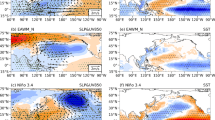Abstract
Characteristics of the ocean state simulated with the Finite-Element Sea-Ice Ocean Model (FESOM) under the normalized year forcing of Coordinated Ocean-ice Reference Experiments (COREs; Griffies et al., Ocean Model 26:1–46, 2009) are compared with those of other models participating in COREs. In contrast to these models, FESOM is run on an unstructured mesh (with resolution varying between 20 and 150 km). It is shown that the ocean state simulated by FESOM is in most cases within the spread of other models, demonstrating that the unstructured mesh technology has reached the stage when it becomes a reliable tool for studying the large-scale ocean general circulation.









Similar content being viewed by others
References
Cavalieri DJ, Parkinson CL, Vinnikov KY (2003) 30-Year satellite record reveals contrasting Arctic and Antarctic decadal sea ice variability. Geophys Res Lett 30(18). doi:10.1029/2003GL018031
Conkright ME, Levitus S, Antonov JI, Baranova O, Boyer TP, Garcia HE, Gelfeld R, Johnson D, Locarnini RA, O’Brien TD, Smolyar I, Stephens C (2002) World ocean database 2001 and world ocean atlas 2001. American Geophysical Union, Washington
Cunningham SA, Kanzow T, Rayner D, Baringer MO, Johns WE, Marotzke J, Longworth HR, Grant EM, Hirschi JJM, Beal LM, Meinen CS, Bryden HL (2007) Temporal variability of the Atlantic meridional overturning circulation at 26.5N. Science 317:935–938
Danilov S, Kivman G, Schröter J (2004) A finite-element ocean model: principles and evaluation. Ocean Model 6(2):125–150. doi:10.1016/S1463-5003(02)00063-X
Danilov S, Wang Q, Losch M, Sidorenko D, Schröter J (2008) Modeling ocean circulation on unstructured meshes: comparison of two horizontal discretizations. Ocean Dynamics 58:365–374. doi:10.1007/s10236-008-0138-5
Gent PR, McWilliams JC (1990) Isopycnal mixing in ocean circulation models. J Phys Oceanogr 20:150–155
Griffies SM (1998) The GentMcWilliams skew flux. J Phys Oceanogr 28:831–841
Griffies SM, Gnanadesikan A, Pacanowski RC, Larichev VD, Dukowicz JK, Smith RD (1998) Isoneutral diffusion in a z-Coordinate Ocean Model. J Phys Oceanogr 28(5):805–830. doi:10.1175/1520-0485(1998)028<0805:IDIAZC>2.0.CO;2
Griffies SM, Biastoch A, Böning C, Bryan F, Danabasoglu G, Chassignet EP, England MH, Gerdes R, Haak H, Hallberg RW, Hazeleger W, Jungclaus J, Large WG, Madec G, Pirani A, Samuels BL, Scheinert M, Gupta AS, Severijns CA, Simmons HL, Treguier AM, Winton M, Yeager S, Yin J (2009) Coordinated ocean-ice reference experiments (cores). Ocean Model 26(1–2):1–46. doi:10.1016/j.ocemod.2008.08.007
Johnson GC, Sloyan BM, Kessler WS, McTaggart KE (2002) Direct measurements of upper ocean currents and water properties across the tropical pacific during the 1990s. Prog Oceanogr 52:31–61
Large WG, Yeager SG (2004) Diurnal to decadal global forcing for ocean and sea-ice models: the data sets and flux climatologies. NCAR, technical Report TN-460+STR
Pacanowski R, Philander S (1981) Parameterization of vertical mixing in numerical models of tropical oceans. J Phys Oceanogr 11:1443–1451
Redi MH (1982) Oceanic Isopycnal Mixing by Coordinate Rotation. J Phys Oceanogr 12(10):1154–1158. doi:10.1175/1520-0485(1982)012<1154:OIMBCR>2.0.CO;2
Timmermann R, Hellmer H, Beckmann A (2002) Simulations of ice-ocean dynamics in the weddell sea 2. Interannual variability 1985–1993. J Geophys Res 107. doi:10.1029/2000JC000742
Timmermann R, Danilov S, Schröter J, Böning C, Sidorenko D, Rollenhagen K (2009) Ocean circulation and sea ice distribution in a finite element global sea ice-ocean model. Ocean Model 27(3–4):114–129. doi:10.1016/j.ocemod.2008.10.009
Trenberth KE, Caron JM (2001) Estimates of meridional atmosphere and ocean heat transports. J Climate 4(16):3433–3443. doi:10.1175/1520-0442(2001)014<3433:EOMAAO>2.0.CO;2
Wang Q, Danilov S, Schröter J (2008) Finite element ocean circulation model based on triangular prismatic elements, with application in studying the effect of topography representation. J Geophys Res 113(2):21. doi:10.1029/2007JC004482
Whitworth T (1983) Monitoring the transport of the antarctic circumpolar current at drake passage. J Phys Oceanogr 13:2045–2057
Whitworth T, Peterson R (1985) Volume transport of the antarctic circumpolar current from bottom pressure measurements. J Phys Oceanogr 15:810–816
Whitworth T, Nowlin W, Worley S (1982) The net passage of the antarctic circumpolar current through drake passage. J Phys Oceanogr 12:960–971
Willebrand J, Barnier B, Böning C, Dieterich C, Killworth PD, Provost CL, Jia Y, Molines JM, New AL (2001) Circulation characteristics in three eddy-permitting models of the north atlantic. Prog Oceanogr 48(2–3):123–161. doi:10.1016/S0079-6611(01)00003-9
Acknowledgements
This work was supported by the Helmholtz Climate Initiative REKLIM (Regional Climate Change). The computational resources for this work were provided through the North-German Supercomputing Alliance (HLRN). We are indebted to Martin Losch and Ralph Timmermann for discussions and advice.
Author information
Authors and Affiliations
Corresponding author
Additional information
Responsible Editor: Eric Deleersnijder
Rights and permissions
About this article
Cite this article
Sidorenko, D., Wang, Q., Danilov, S. et al. FESOM under coordinated ocean-ice reference experiment forcing. Ocean Dynamics 61, 881–890 (2011). https://doi.org/10.1007/s10236-011-0406-7
Received:
Accepted:
Published:
Issue Date:
DOI: https://doi.org/10.1007/s10236-011-0406-7




